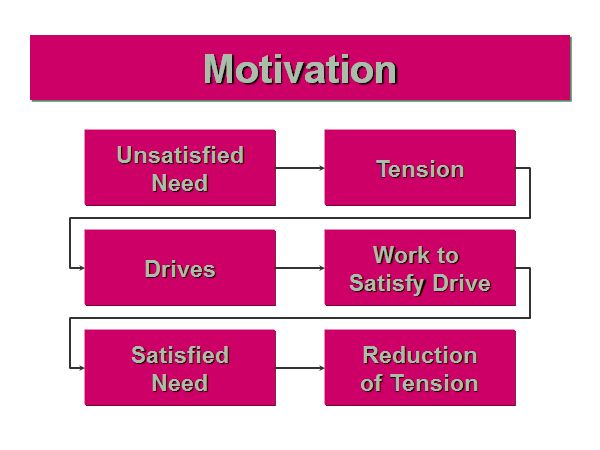1. We define motivation as the processes that account for an individual’s intensity, direction, and persistence of effort toward attaining a goal
Components
1.) Intensity/Arousal - Drive or energy behind our actions
2.) Direction - Choices regarding which goals to pursue
3.) Persistence - Continuation of commitment to a goal
2. Extrinsic vs. Intrinsic motivation
Extrinsic: Performance to obtain an external outcome
Intrinsic: Performance for the inherent satisfaction of the activity itself
3. Maslow’s hierarchy of needs
1) Physiological. Includes hunger, thirst, shelter, sex, and other bodily needs.
2) Safety. Security and protection from physical and emotional harm.
3) Social. Affection, belongingness, acceptance, and friendship.
4) Esteem. Internal factors such as self-respect, autonomy, and achievement, and external factors such as status, recognition, and attention.
5) Self-actualization. Drive to become what we are capable of becoming; includes growth, achieving our potential, and self-fulfillment.
4. Theory X and Theory Y
-Under Theory X, managers believe employees inherently dislike work and must therefore be directed or even coerced into performing it.
-Under Theory Y, in contrast, managers assume employees can view work as being as natural as rest or play, and therefore the average person can learn to accept, and even seek, responsibility.
5.Two-Factor Theory
Motivational Factors:
•Career Advancement
•Personal growth
•Recognition
•Responsibility
•Achievement
Hygiene Factors:
•Quality of supervision
•Rate of pay
•Company policies
•Working conditions
•Relations with others
•Job security
6.McClelland’s theory of needs
● Need for achievement (nAch) is the drive to excel, to achieve in relationship to a set of standards.
● Need for power (nPow) is the need to make others behave in a way they would not have otherwise.
● Need for affiliation (nAff) is the desire for friendly and close interpersonal relationships.
7. Self-determination theory (SDT)
People have three fundamental, psychological needs
•Autonomy- Self determination
•Competence- Agency, self-efficacy
•Relatedness- Meaningful social connections
Control
Goals consistent with interests
Intrinsic motivation
8. Adams’ Equity Theory:
People strive to maintain a ratio of their own outcomes (rewards) to their own inputs (contributions) equal to the outcome/input ratio of others with whom they compare themselves
Reward - the rewards, such as salary and recognition, that employees receive from their jobs
Effort - people’s contributions to their jobs
9. 3 Types of Organizational Justice :
Distributive Justice (Equity Theory) - Perceived fairness of the outcomes themselves
Procedural Justice - Perceived fairness of the process used in resource allocation decisions
Interactional Justice - Perceived degree to which one is treated with dignity and respect
10. Expectancy Theory
Expectancy:
- If I work harder, will I produce more?
Instrumentality:
- If I produce more, will I get promoted faster?
Valence:
- Do I want a promotion? Is it worth the extra effort
Motivational Force = Expectancy * Instrumentality * Valence
- if any component is zero, overall level of motivation is also zero
11. Goal-Setting Theory
Specific, challenging goals are best
Focus
Energy
Persistence
ALSO NEEDS
Goal commitment = Importance + Self-efficacy
Feedback
Task complexity
downside of goals:
Some evidence that difficult performance goals increase likelihood of risky strategies and unethical behaviors
Goals can be “too motivating”
- People don’t deviate from the goal
- No exceeding the goal
- No sense of the bigger picture
- No creativity
SMART goals setting:
SPECIFIC, MEASURABLE, ACHIEVABLE, REASONABLE, TIMETABLE
12. Fixed vs. Growth Mindset
Fixed mindset – Basic qualities (like intelligence) are fixed
Growth mindset – Belief that basic abilities can be developed through dedication & hard work.

